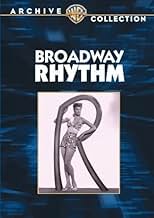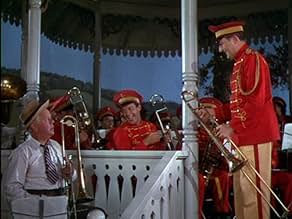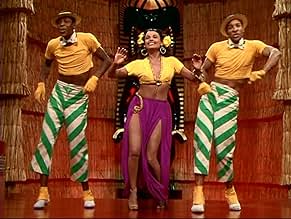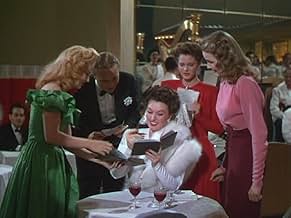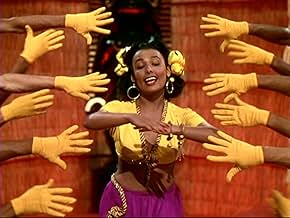Aggiungi una trama nella tua linguaA reluctantly-retired vaudevillian clashes with his producer son, who thinks his father's entertainment is passe'--audiences need something more sophisticated. Meanwhile, the producer's fath... Leggi tuttoA reluctantly-retired vaudevillian clashes with his producer son, who thinks his father's entertainment is passe'--audiences need something more sophisticated. Meanwhile, the producer's father and sister secretly produce their own show.A reluctantly-retired vaudevillian clashes with his producer son, who thinks his father's entertainment is passe'--audiences need something more sophisticated. Meanwhile, the producer's father and sister secretly produce their own show.
- Regia
- Sceneggiatura
- Star
- Maggie
- (as The Ross Sisters)
- Aggie
- (as The Ross Sisters)
- Elmira
- (as The Ross Sisters)
Recensioni in evidenza
I will always try a movie that has any of the big name swing bands in it. I grew up with that music in the 1940s and 50s, before rock 'n roll; and the swing era had so many super talented musicians and bands that it showcased. Since it made the vocalists so popular, we've not had another time (other than classical or pops concerts) in which the music makers have been in the spotlight. And yet, swing era music lives on more than any other genre as background and theme music in movies.
So, the cast in this one is quite good and all the technical aspects of the show are fine. Tommy Dorsey has a decent role with some good lines beside his playing and leading his band. I think he's one of the better of the band leaders at acting too. Lena Horne has two dazzling numbers in "Brazilian Boogie Woogie," and "Somebody Loves Me." Ginny Simms sings three romantic songs: "Amour, Amour," "Irresistible You," and "All the Things You Are." Gloria DeHaven has a couple of nice songs and dances. Walter B. Long is one of those unknowns who only appeared in two films – but here he does some dazzling dancing. Another person I might not have heard play was Hazel Scott, an outstanding classical and jazz pianist, born in Trinidad. She really makes the piano sing and dance in this movie. A number of other people sing and dance their way through this film with lots of fun. Of course, that includes George Murphy in the lead as Broadway producer Johnny Demming, and his pop, Sam, played by old-hand actor and terrific performer Charles Winninger. One other act in this film was very interesting and entertaining – again something one would only see in a stage revue or show like this. The Ross sisters – Aggie, Elmira and Maggie, do a nice song and dance number – I think it's called "Potato Salad" that include some fantastic acrobatics on their part. They all three must have been triple-joined.
The popularity of this type of entertainment didn't wane for decades. But it took to new venues. In the 1950s, singing stars left the big bands that 'discovered' them, and began performing on their own. Some would develop their own bands. They toured the country giving concerts. They would usually include other performers and acts – to the give stars a break, if for no other reason. There were crooners like Bing Crosby and Dean Martin, jazz and blues singers like Louis Prima and Lena Horne, pop singers from the swing bands such as Frank Sinatra and Kay Francis, and rock and roll singers such as Elvis Presley and Jerry Lee Lewis. Early television began to sponsor variety shows, and helped discover more talents – or propel them into the spotlight and fame, as it did Elvis Presley. Ed Sullivan was the king of the variety and review type show on TV for many years. The Ed Sullivan Show (aka, The Toast of the Town) ran for 23 years from 1948 to 1971. It was the longest running variety show broadcast in history. That was a new venue for the revue type of shows.
I enjoy all types of musicals, and think that the type of entertainment we see in films such as "Broadway Rhythm" just doesn't have a public venue in the 21st century. To see something like this film today, one would have to go to a concert and buy tickets that would cost in the range of $50 to $100 or more. But, here we have it on film, and can watch it in the uncrowded comfort of our homes. I highly recommend "Broadway Rhythm" just for the music and dancing entertainment alone.
Based on a successful Broadway show, Very Warm for May, that the producers chose to cut to ribbons taking many of the songs out and turning into an ordinary backstage story of a brash blow-hard trying to put on a show.
A big indicator of the lower expectations that befell the property is the cast. None of the top line Metro stars are on board.
While originally intended for Judy Garland the lead is now filled by lesser light Ginny Simms. Simms had a beautiful voice and a lovely face but knowing the part was meant for Judy allows the viewer to consider star quality and the impact one performer makes on screen over another. Whereas Judy was always relaxed, natural and alive when the cameras were trained on her Ginny comes across as stiff and uneasy. You can almost see her counting down until the other person in the scene finishes talking so she can say her lines. However when she sings she's more at ease and accessible. This was to be her big chance at above the title screen stardom but the movie was an under performer and after a few more supporting roles, one in Night and Day showed her to good advantage, she went back to the bandstand. She doesn't ruin the film but she doesn't help it much.
The next performer that indicates the lower expectations of the picture is George Murphy in the lead. A top star in 30's musicals and a fine dancer he had moved down to second leads and B's by this point so his casting in this as opposed to Gene Kelly or Fred Astaire shows the studio didn't firmly believe in the material.
It's not all bad, the supporting cast has a few saving graces, although Gloria De Haven is arch and annoying. Charles Winninger and Rochester are there with their stock but amusing characters and blessedly Nancy Walker adds spice whenever she shows up on the scene, to bad her part wasn't bigger.
As was the custom at the time the film has several specialty numbers and they are a very mixed bag.
The bad: impressionist Dean Murphy while not untalented tries way too hard in his bit. Contortionist sister act The Ross Sisters are remarkably limber but their routine is downright creepy.
The good: Although I'm not a fan Lena Horne comes across well in her two numbers and the great Hazel Scott tears it up at the piano working her special magic.
Filmed in rich eye popping Technicolor this is a pleasant diversion but nowhere near the peak of what MGM was capable of at this point. For that see the same year's Meet Me in St. Louis.
Lo sapevi?
- QuizNightclub impressionist Dean Murphy plays the Hired Man in a barnyard scene with Nancy Walker. He impersonates several celebrities of the day in the following order: Joe E. Brown, Edgar Bergen as Charlie McCarthy then Mortimer Snerd, Clark Gable, Ronald Colman, Wendell Willkie, Bette Davis, James Stewart, Franklin D. Roosevelt and finally Eleanor Roosevelt.
- BlooperImpressionist Dean Murphy, impersonating Joe E. Brown, is in a barnyard sketch with Nancy Walker. His armpit sweat varies from shot to shot - very wet, a couple smalls spots, dry and wet again.
- Citazioni
Jonnie Demming: Here we are - three weeks before the opening and we haven't got a leading lady.
- ConnessioniFeatured in That's Entertainment! III (1994)
- Colonne sonoreSomebody Loves Me
Music by George Gershwin
Lyrics by Ira Gershwin (incorrectly credited)
Lyrics by Ballard MacDonald (uncredited) and Buddy G. DeSylva (uncredited)
Sung by Lena Horne (uncredited)
I più visti
Dettagli
- Tempo di esecuzione1 ora 55 minuti
- Proporzioni
- 1.33 : 1
Contribuisci a questa pagina


